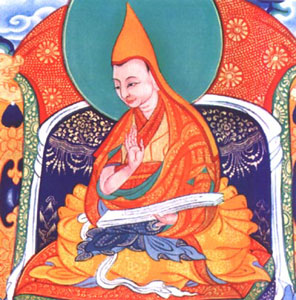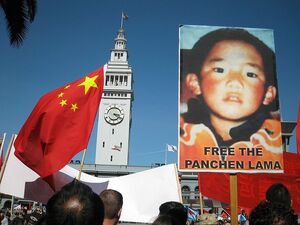
Khedrup Je, 1st Panchen Lama
|
Part of a series on Tibetan Buddhism | |
|---|---|
| History | |
| Timeline · Related-topics | |
| Schools | |
| Nyingma · Kagyu · Sakya · Gelug · Bön | |
| Key Concepts | |
| Three marks of existence · Skandha · Cosmology · Saṃsāra · Rebirth · Bodhisattva · Dharma · Dependent Origination · Karma | |
| Major Figures | |
| Gautama Buddha · Padmasambhava · Je Tsongkhapa · Dalai Lama · Panchen Lama · Lama · Karmapa Lama · Rinpoche · Geshe · Terton · Tulku | |
| Buddhahood · Avalokiteśvara · Four Stages of Enlightenment · Tantric yoga · Paramitas · Meditation · Laity | |
|
Major Monasteries | |
| Changzhug · Drepung · Dzogchen · Ganden · Jokhang · Kumbum · Labrang · Mindroling · Namgyal · Narthang · Nechung · Pabonka · Palcho · Ralung · Ramoche · Sakya · Sanga · Sera · Shalu · Tashilhunpo · Tsurphu · Yerpa | |
| Chotrul Duchen · Dajyur · Losar · Monlam · Sho Dun | |
| Texts | |
| Kangyur · Tengyur · Tibetan Canon · Mahayana Sutras | |
|
Art | |
| Sand mandala · Thangka · Ashtamangala · Tree of physiology | |
|
Outline · Comparative Studies · Culture · List of topics · Portal | |
The Panchen Lama (Tibetan: པན་ཆེན་བླ་མ; Wylie: Pan-chen Bla-ma, simplified Chinese: 班禅喇嘛/班禅额尔德尼; traditional Chinese: 班禪喇嘛/班禪額爾德尼) is the second highest ranking Lama after the Dalai Lama in the Gelugpa (Dge-lugs-pa) sect of Tibetan Buddhism (the sect which controlled western Tibet from the 16th century until the establishment of Chinese sovereignty in 1951). The successive Panchen lamas form a tulku reincarnation lineage which are said to be the incarnations of Amitabha Buddha. The name, meaning "great scholar", is a Tibetan contraction of the Sanskrit paṇḍita (scholar) and the Tibetan chenpo (great).
Panchen Lama traditionally lived in Tashilhunpo Monastery in Shigatse.
The current Panchen Lama[]
The present (11th) incarnation of the Panchen Lama is a matter of controversy: the People's Republic of China asserts it is Qoigyijabu (Gyancain Norbu), while the current Dalai Lama, Tenzin Gyatso (Bstan-'dzin Rgya-mtsho), named Gedhun Choekyi Nyima on May 14, 1995. The latter vanished from public eye shortly after being named. Chinese authorities state that Gedhun Choekyi Nyima has been taken into protective custody, but there is no information regarding from what, or from whom, he must be protected, where he is being held, or under what conditions. A controversy also existed between the local Tibet government (the Gasha) and the People's Republic of China during the recognization of the 10th Panchen Lama.[1]
The recognition of Panchen Lamas has always been a matter involving the Dalai Lama [2][3]. The 10th Panchen Lama himself declared, as cited by an official Chinese review that "according to Tibetan tradition, the confirmation of either the Dalai or Panchen must be mutually recognized."[4] The involvement of China in this affair is seen by some as a political ploy to try to gain control over the recognition of the next Dalai Lama (see below), and to strengthen their hold over the future of Tibet and its governance. China claims however, that their involvement does not break with tradition in that the final decision about the recognition of both the Dalai Lama and the Panchen Lama traditionally rested in the hands of the Chinese emperor. For instance, after 1792 and the use of Golden Urn, 10th, 11th and 12th Dalai Lama had all been recognized by Chinese emperors and after Qing Dynasty, Republic of China took over the role and certified the current 14th Dalai and the previous 10th Panchan. [5]

Gedhun Choekyi Nyima
Relation to the Dalai Lama Lineage[]
The Panchen Lama bears part of the responsibility or the monk-regent for finding the incarnation of the Dalai Lama and vice versa Furthermore, the search for the late Panchen Lama's reincarnation, or any reincarnation, is a philosophic matter In the case of the Panchen Lama, the procedures traditionally involve a final selection process by the Dalai Lama This has been the tradition since the Fifth Dalai lama, Ngawang Lobsang, recognized his teacher Lobsang Choekyi Gyaltsen as the Panchen (Great Scholar) Lama of Tashilhunpo Monastery (Bkra-shis Lhung-po) in Shigatse (Gzhis-ka rtse). With this appointment, Lobsang Choekyi Gyaltsen's three previous incarnations were posthumously recognised as Panchen Lamas. The Fifth Dalai Lama also recognized Panchen Lobsang Yeshe (Blo-bzang Ye-shes) as the Fifth Panchen Lama. The Seventh Dalai Lama recognized the Sixth Panchen Lama, who in turn recognized the Eighth Dalai Lama. Similarly, the Eighth Dalai Lama recognised the Seventh Panchen Lama.[6]
Choekyi Gyaltsen, the 10th Panchen Lama, became the most important political and religious figure in Tibet following the 14th Dalai Lama's escape to India in 1959. In April, 1959 the 10th Panchen Lama sent a telegram to Beijing expressing his support for suppressing the 1959 rebellion. “He also called on Tibetans to support the Chinese government.” [7] However, in 1964, he was imprisoned.[8] His situation worsened when the Cultural Revolution began. The Chinese dissident Wei Jingsheng wrote in March 1979 a letter denouncing the inhumane conditions of the Chinese Qincheng Prison where the late Panchen Lama was imprisoned.[9] In October 1977, he was released but held under house arrest in Beijing until 1982. In 1979, he married a Han Chinese woman and in 1983 they had a daughter,[10] which was considered controversial for a Gelug lama. In 1989, the 10th Panchen Lama died suddenly in Shigatse, Tibet, at the age of 51, shortly after giving a speech critical of the Chinese neglect for the religion and culture of the Tibetans.[11] His daughter, now a young woman, is Yabshi Pan Rinzinwangmo, better known as "Renji".[12]
Lineage of the Panchen Lamas[]
In the lineage of the Tibetan Panchen Lamas there were considered to be four Indian and three Tibetan incarnations of Amitabha Buddha before Khedrup Gelek Pelzang, who is recognised as the 1st Panchen Lama. The lineage starts with Subhuti, one of the original disciples of Gautama Buddha. Gö Lotsawa is considered to be the first Tibetan incarnation of Amitabha Buddha in this line.[13][14]
List of Panchen Lamas[]
| Name | Life span | Tibetan/Wylie | PRC transcription | Other transliterations | |
|---|---|---|---|---|---|
| 1. | Khedrup Je | 1385–1438[15] | མཁས་གྲུབ་རྗེ་་ Mkhas-grub Rje,་ མྷས་གྲུབ་དགེལེགས་དཔལ་བཟང་ Mkhas-grub Dge-legs Dpal-bzang-po |
Kaichub Gêlêg Baisangbo | Khädrup Je, Khedrup Gelek Pelsang, Kedrup Geleg Pelzang, Khedup Gelek Palsang, Khedrup Gelek Pal Sangpo |
| 2. | Sönam Choklang | 1438–1505[15] | བསོད་ནམས་ཕྱོག་ཀྱི་གླང་པོ་་ Bsod-nams Phyogs-glang,་ བསོད་ནམས་ཕྱོགས་ཀྱི་གླང་པོ་ Bsod-nams Phyogs-kyi Glang-po |
Soinam Qoilang, Soinam Qoigyi Langbo |
Sonam Choglang, Soenam Choklang |
| 3. | Ensapa Lobsang Döndrup | 1505–1568[15] | དབེན་ས་པ་བློ་བཟང་དོན་དྲུཔ་་ Dben-sa-pa Blo-bzang Don-grub |
Wênsaba Lobsang Toinchub | Gyalwa Ensapa, Ensapa Lozang Döndrup, Ensapa Losang Dhodrub |
| 4. | Lobsang Chökyi Gyalsten | 1570–1662 | བློ་བཟང་ཆོས་ཀྱི་རྒྱལ་མཚན་་ Blo-bzang Chos-kyi Rgyal-mtshan |
Lobsang Qoigyi Gyaicain | Losang Chökyi Gyältsän, Lozang Chökyi Gyeltsen, Lobsang Chökyi Gyaltsen, Lobsang Choekyi Gyaltsen, Lobsang Choegyal, Losang Chögyan |
| 5. | Lobsang Yeshe | 1663–1737 | བློ་བཟང་ཡེ་ཤེས་་ Blo-bzang Ye-shes |
Lobsang Yêxê | Lobsang Yeshi, Losang Yeshe |
| 6. | Lobsang Palden Yeshe | 1738–1780 | བློ་བཟང་གྤལ་ལྡན་ཡེ་ཤེས་་ Blo-bzang Gpal-ldan Ye-shes |
Lobsang Baidain Yêxê | Palden Yeshe, Palden Yeshi |
| 7. | Palden Tenpai Nyima | 1782–1853 | གྤལ་ལྡན་བསྟན་པའི་ཉི་མ་་ Gpal-ldan Bstan-pa'i Nyi-ma |
Dainbai Nyima | Tänpä Nyima, Tenpé Nyima, Tempai Nyima, Tenpey Nyima |
| 8. | Tenpai Wangchuk | 1855?–1882 | བསྟན་པའི་དབང་ཕྱུག་་ Bstan-pa'i Dbang-phyug |
Dainbai Wangqug | Tänpä Wangchug, Tenpé Wangchuk, Tempai Wangchuk, Tenpey Wangchuk |
| 9. | Thubten Chökyi Nyima | 1883–1937 | ཐུབ་བསྟན་ཆོས་ཀྱི་ཉི་མ་་ Thub-bstan Chos-kyi Nyi-ma |
Tubdain Qoigyi Nyima | Choekyi Nyima, Thubtän Chökyi Nyima |
| 10. | Lobsang Trinley Lhündrub Chökyi Gyaltsen | 1938–1989 | བློབཟང་ཕྲིན་ལས་ལྷུན་གྲུབ་ ཆོས་ཀྱི་རྒྱལ་མཚན་་ Blo-bzang Phrin-las Lhun-grub Chos-kyi Rgyal-mtshan |
Lobsang Chinlai Lhünchub Qoigyi Gyaicain | Choekyi Gyaltsen, Chökyi Gyeltsen, Choekyi Gyaltse, Trinley Choekyi Gyaltsen, Lozang Trinlä Lhündrup Chökyi Gyältsän |
| 11. | Gedhun Choekyi Nyima[16] | 1989– | དགེ་འདུན་ཆོས་ཀྱི་ཉི་མ་་ Dge-'dun Chos-kyi Nyi-ma |
Gêdün Qoigyi Nyima | Gendün Chökyi Nyima, Gendhun Choekyi Nyima |
| Gyancain Norbu[16] | 1990– | ཆོས་ཀྱི་རྒྱལ་པོ་་ Chos-kyi Rgyal-po |
Qoigyijabu | Choekyi Gyalpo, Chökyi Gyälbo, Gyaincain Norbu, Gyaltsen Norbu |
Footnotes[]
- ↑ 九世班禅转世灵童寻访和认定纪略(Chinese)
- ↑ et :Ya Hanzhang, Biographies of the Tibetan Spiritual Leaders Panchen Erdenis. Beijing: Foreign Language Press, 1987. pg 350.
- ↑ When the sky fell to earth
- ↑ Panchen-lama. 1988. "On Tibetan Independence." China Reconstructs (now named China Today) (January): Vol. 37, No. 1. pp 8–15.
- ↑ See Melvyn Goldstein's book "A History of Modern Tibet, 1913-1951: The Demise of the Lamaist State". University of California Press. ISBN 0520075900. Emperors of the Qing Dynasty certified and approved the choices of both Dalai and Panchan Lamas. For example, the tradition of using the Golden Urn, which is unrelated to the religious or spiritual proceedings preferred by Tibetan Buddhists, had been introduced in the year 1792 by the Qianlong Emperor of China to deal with a previous controversy. After the Qing Dynasty, Republic of China's government took over the role. Both the current Dalai XIV and the previous Panchan X were certified by the Republic of China's government.
- ↑ Appeal For Chatral Rinpoche's Release, from the website of "The Office of Tibet, the official agency of His Holiness the Dalai Lama in London"
- ↑ Lee Feigon, Demystifying Tibet, page 163.
- ↑ Exploring Chinese History :: East Asian Region :: Tibet
- ↑ Excerpts from Qincheng: A Twentieth Century Bastille, published in Exploration, March 1979
- ↑ BUDDHA'S DAUGHTER: A YOUNG TIBETAN-CHINESE WOMAN
- ↑ "Panchen Lama Poisoned arrow". BBC. 2001-10-14. http://www.bbc.co.uk/dna/h2g2/A644320. Retrieved 2007-04-29.
- ↑ Hilton, Isabel (March 29, 2004). "The Buddha's Daughter: Interview with Yabshi Pan Rinzinwangmo". The New Yorker.
- ↑ Stein, R. A. Tibetan Civilization, (1972) p. 84. Stanford University Press, Stanford, California. ISBN 0-8047-0806-1 (cloth); ISBN 0-0847-0901-7.
- ↑ Das, Sarat Chandra. Contributions on the Religion and History of Tibet (1970), p. 82. Manjushri Publishing House, New Delhi. First published in the Journal of the Asiatic Society of Bengal, Vol. LI (1882).
- ↑ 15.0 15.1 15.2 The title Panchen Lama was conferred posthumously on the first two Panchen Lamas.
- ↑ 16.0 16.1 The Tibetan government-in-exile under the 14th Dalai Lama recognizes Gedhun Choekyi Nyima as the 11th Panchen Lama; the government of the People's Republic of China recognizes Qoigyijabu as the 11th Panchen Lama.
References[]
- Kapstein, Matthew T. (2006). The Tibetans. Blackwell Publishing. Oxford, U.K. ISBN 978-0-631-22574-4.
External links[]
- Tibet Society UK - The Background To The Panchen Lama from http://www.tibet-society.org.uk/
- China Tibetology No. 03, a series of articles from http://www.tibet.cn/ explaining in detail the Chinese government's position on the search of reincarnations of the Panchen Lama:
- Preface
- The reincarnation of Living Buddhas of Tibetan Buddhism and the administration over Living Buddhas exercised by central governments
- The Grand Living Buddha Reincarnation System in the dGe-lugs-pa Sect and the Central Government Strengthening the Governing of the Reincarnation of Living Buddhas
- A Successful Example in Searching and Confirming the Eleventh Panchen Lama Set for the Reincarnation of Grand Living Buddhas of Tibetan Buddhism in a New Historical Condition
- Tibet's missing spiritual guide, a May 2005 article from BBC News
- 11th Panchen Lama of Tibet, a website about Gedhun Choekyi Nyima
- The Search for the Panchen Lama, The non-fictional story of the Panchen Lama's disappearance, written by Isabel Hilton.
- The Dharma King, The Dharma King is a novel, written by Bradford Stroh, about one man's quest to find the reincarnated Panchen Lama.
- Some or all of this article is forked from Wikipedia. The original article was at Panchen Lama. The list of authors can be seen in the page history.
| |||||||
